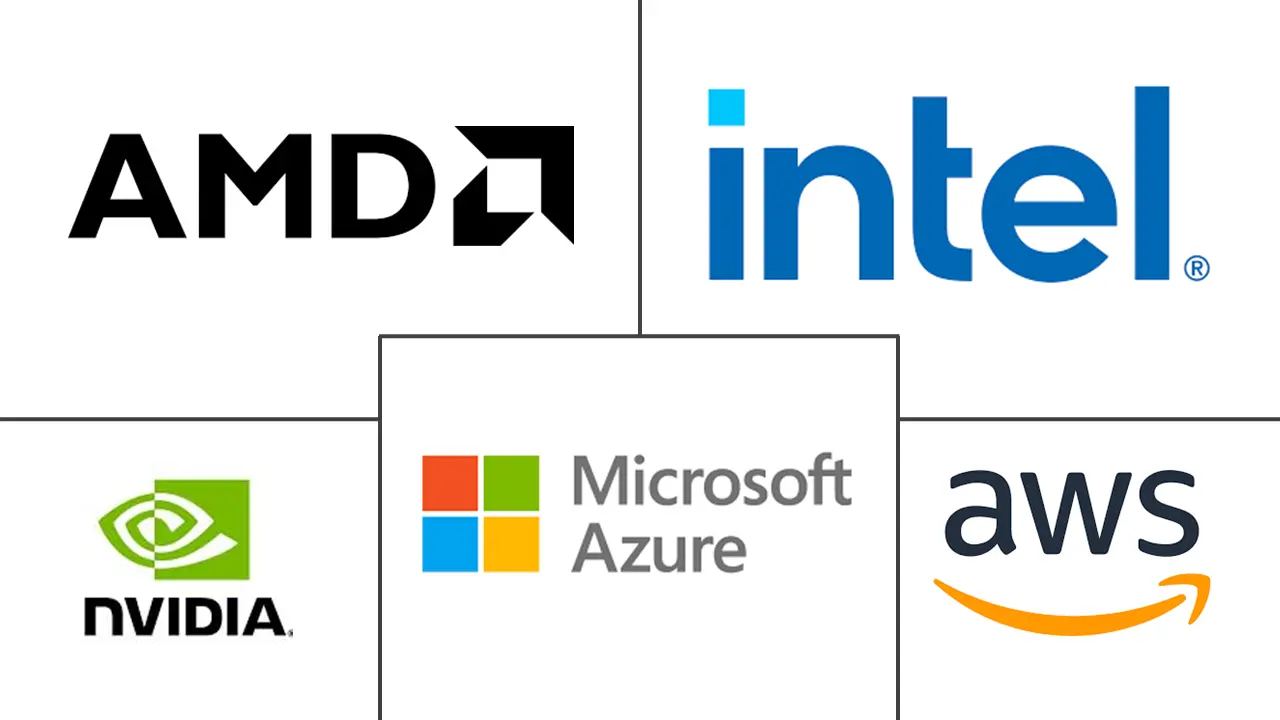AI Infrastructure Market Size and Share
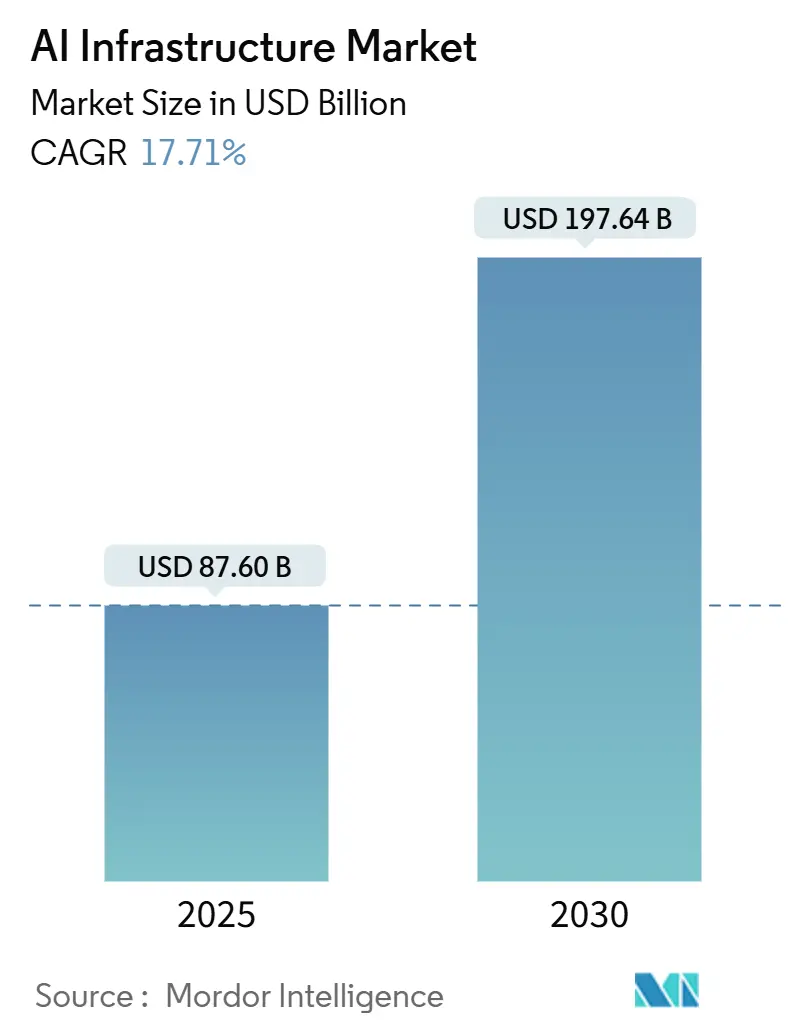
AI Infrastructure Market Analysis by Mordor Intelligence
The AI Infrastructure Market size is estimated at USD 87.60 billion in 2025, and is expected to reach USD 197.64 billion by 2030, at a CAGR of 17.71% during the forecast period (2025-2030).
Market Analysis
Growth reflects the decisive shift from limited pilots to production-scale rollouts, especially among hyperscalers, enterprises, and public-sector agencies that now depend on purpose-built compute, high-bandwidth fabrics, and advanced thermal management to run large language and generative AI models. Rapid cloud-native accelerator availability lowers capital barriers, and combined hardware, software, and facilities investments above USD 315 billion in 2025 by the three largest hyperscalers underscore the scale imperative. Hardware retains 72.1% share in 2024, yet software’s 19.7% CAGR highlights a move toward holistic platforms rather than discrete compute islands. Regionally, North America commands a 47.7% share, but Asia-Pacific’s 19.1% CAGR signals sovereign AI strategies and manufacturing digitization initiatives accelerating local demand. End-user patterns mirror this transformation: cloud service providers account for 51.3% of spending, while the enterprise segment’s 21% CAGR shows that AI is becoming a core operational capability rather than a research exercise.
Key Report Takeaways
- By offering, hardware led the AI infrastructure market with 72.1% revenue share in 2024; software is expanding at a 19.7% CAGR through 2030.
- By deployment, on-premises installations held 56.4% of the AI infrastructure market share in 2024, while cloud solutions are projected to grow at a 20.6% CAGR to 2030.
- By end user, cloud service providers contributed 51.3% of the AI infrastructure market size in 2024; enterprise demand is forecast to rise at a 21% CAGR over the same period.
- By processor architecture, GPUs captured 67.4% of the AI infrastructure market revenue in 2024 and are projected to advance at a 17.9% CAGR to 2030.
- By geography, North America controlled 47.7% of global AI infrastructure spending in 2024; Asia-Pacific is on course for the fastest 19.1% CAGR through 2030.
Global AI Infrastructure Market Trends and Insights
Drivers Impact Analysis
| Driver | (~) % Impact on CAGR Forecast | Geographic Relevance | Impact Timeline |
|---|---|---|---|
| Soaring H100/G100 GPU backlogs among hyperscalers | +3.2% | Global, concentrated in North America and Asia-Pacific | Medium term (2-4 years) |
| Rapid AI-specific network fabrics (Infiniband NDR, Ethernet 800G) | +2.8% | Global, early adoption in North America and EU | Short term (≤ 2 years) |
| Energy-efficient liquid cooling adoption | +1.9% | Global, regulatory-driven in EU, efficiency-driven in Asia Pacific | Medium term (2-4 years) |
| Government CHIPS-type subsidies for AI fabs | +2.1% | North America, EU, selective Asia-Pacific markets | Long term (≥ 4 years) |
| Cloud-native AI accelerator instances democratise access | +4.3% | Global, strongest in North America and EU | Short term (≤ 2 years) |
| Open-source AI framework optimisation (e.g., Triton, TVM) | +1.5% | Global, developer-community driven | Medium term (2-4 years) |
| Source: Mordor Intelligence | |||
Soaring H100/G100 GPU Backlogs Among Hyperscalers
Pre-purchase contracts now running into billions have allowed hyperscalers to secure priority access to scarce H100 and next-generation G100 accelerators. Smaller AI firms often wait 12-18 months for delivery, turning GPU allocation into a competitive moat that favors well-capitalized providers. The shortage has also catalyzed GPU-as-a-service specialists such as CoreWeave, which raised USD 11.9 billion to supply on-demand compute capacity. Alternative architectures are gaining mind-share: AMD MI300X shipments are rising, and Intel’s Gaudi 3 is expected to broaden options, but ecosystem maturity still hinges on CUDA compatibility.[1]NVIDIA Corporation, “Spectrum-X800 and Quantum-X800 product brief,” nvidia.com
Rapid AI-Specific Network Fabrics (Infiniband NDR, Ethernet 800 G)
Model sizes have vaulted into the trillion-parameter realm, forcing data-center networks to remove node-to-node latency barriers. NVIDIA Quantum-X800 Infiniband and Spectrum-X800 Ethernet deliver 800 Gb/s links, providing five-fold bandwidth increases over prior iterations and enabling synchronized GPU training at scale. Early adopters including Microsoft Azure and Oracle Cloud Infrastructure have deployed the switches, while optical cable upgrades such as Corning EDGE8 ensure loss-free throughput for dense GPU pods.[2]Corning Inc., “EDGE8 solutions for 800G AI networks,” corning.com
Energy-Efficient Liquid Cooling Adoption
Rack power densities above 40 kW have outstripped the capability of legacy air systems, pushing direct-to-chip and immersion solutions into mainstream production. Deployments cite 10–30% energy savings relative to air cooling and help data centers meet rigorous Scope-2 targets in the EU and California. Microsoft's commitment to zero-water cooling and Google's advanced liquid systems highlight large-scale validation of liquid cooling technology. [3]Microsoft Corporation, “Zero-water cooling at hyperscale,” microsoft.com
Cloud-Native AI Accelerator Instances Democratise Access
More than 50 distinct GPU-enabled instance types across AWS, Microsoft Azure, and Google Cloud now grant enterprises elastic access to H100 clusters for both training and inference workloads. The model shifts budget from capital to operational expenditure, improves time-to-solution, and has triggered a wave of niche clouds that undercut generalist pricing by 30-50% for specific workloads.
Restraints Impact Analysis
| Restraint | (~) % Impact on CAGR Forecast | Geographic Relevance | Impact Timeline |
|---|---|---|---|
| AI-class GPUs in chronic short supply through 2026 | -2.8% | Global, acute in emerging markets | Medium term (2-4 years) |
| 400 V/48 V power-conversion limits in legacy DCs | -1.9% | Global, notable in mature markets | Short term (≤ 2 years) |
| Sovereign-AI export controls | -1.4% | US-China, selected EU jurisdictions | Long term (≥ 4 years) |
| Rising Scope-2 compliance costs | -1.1% | EU, California, expanding elsewhere | Medium term (2-4 years) |
| Source: Mordor Intelligence | |||
AI-Class GPUs in Chronic Short Supply Through 2026
Post-earthquake wafer disruptions and limited advanced node capacity at TSMC have pushed delivery windows to 12–18 months. Hyperscalers insulating themselves with multi-year prepayments exacerbate the imbalance, leaving smaller buyers to pay 30-50% premiums for devices like the RTX 5090. Competitors are responding: AMD is scaling MI300X output while Intel readies Gaudi 3, yet CUDA ecosystem lock-in still skews preference toward NVIDIA devices.
400 V/48 V Power-Conversion Limitations in Legacy DCs
In the AI Infrastructure Market, Traditional data centers designed for 10 kW racks face efficiency losses beyond 15% when serving AI clusters requiring up to 120 kW. Upgrading to 800 V high-voltage direct-current backplanes can cost millions per facility, delaying many projects. The Open Compute Project now advocates power envelopes up to 1 MW per rack, but adoption remains uneven.
Segment Analysis
By Offering: Hardware Dominance Meets Software Acceleration
Hardware accounted for 72.1% of 2024 spending, underscoring the capital intensity of GPU clusters, high-bandwidth memory, and specialty networking. Within the AI infrastructure market size for hardware, processor expenditure remains the largest line-item as H100 clusters scale in the thousands of nodes. Storage architectures continue shifting toward NVMe over Fabrics with integrated HBM caches to avoid I/O stalls.
Software, though smaller, is the fastest-expanding category at 19.7% CAGR. Cross-vendor orchestration stacks, compiler toolchains such as Triton, and MLOps suites unlock higher utilization, pushing organizations to value integrated platforms over raw devices. As a result, total cost-of-ownership calculations increasingly assign one-third of anticipated ROI to software-driven optimization rather than incremental hardware horsepower in the AI infrastructure market.
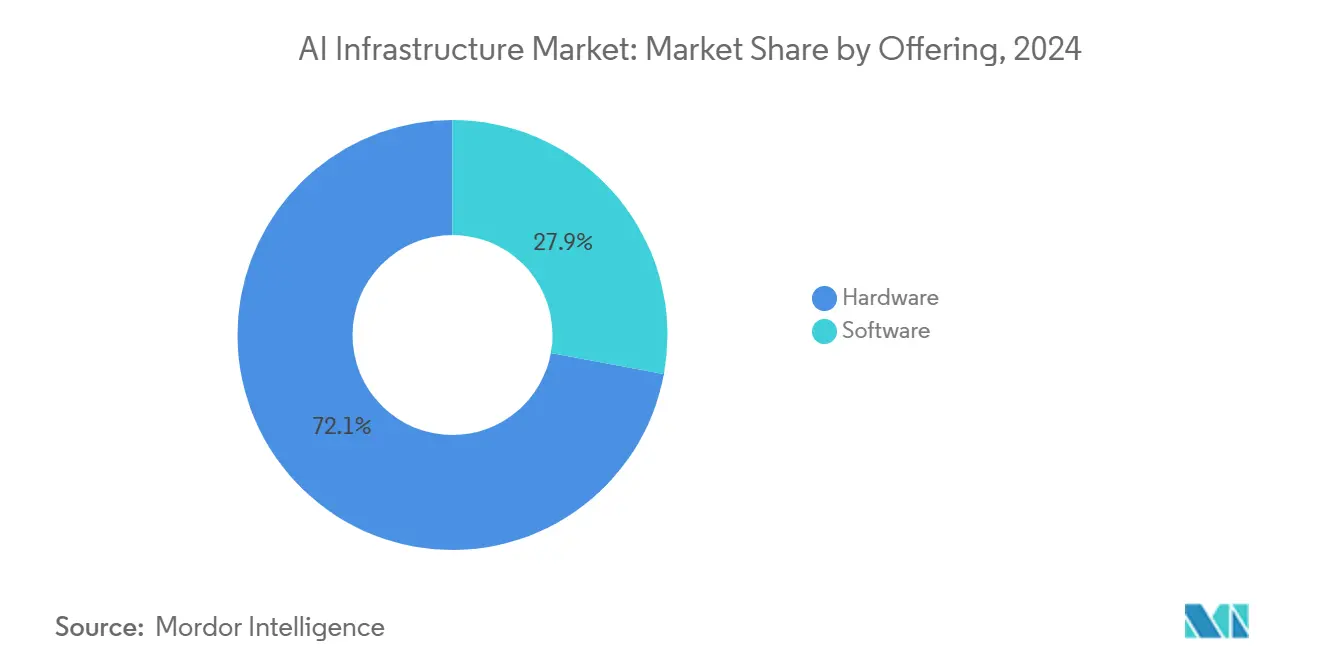
Note: Segment shares of all individual segments available upon report purchase
By Deployment: On-Premises Leadership Challenged by Cloud Transformation
On-premises installations delivered 56.4% of 2024 revenue, driven by latency-sensitive use cases in finance and healthcare. Many firms continue to locate AI workloads near regulated data to navigate privacy rules and maintain deterministic response times for clinical or trading algorithms in the AI Infrastructure Market.
Cloud consumption is scaling faster at 20.6% CAGR. Elastic accelerator instances allow experimentation without capital lock-in, while hybrid approaches balance sovereignty with burst capacity. Microsoft’s pledge to invest USD 80 billion in data centers devoted to AI workloads underlines how hyperscale build-outs are recalibrating capital allocation patterns in the AI infrastructure market.
By End User: CSP Dominance Amid Enterprise Growth Surge
Cloud service providers aggregated 51.3% of the 2024 demand, leveraging scale to extract better pricing on GPUs and networking. Their curated AI-as-a-service offerings absorb complexity, making them a default choice for developers.
Enterprises, however, record a 21% CAGR as AI moves from proof-of-concept to production. Manufacturing, logistics, and medical research adopt local or edge clusters for deterministic inference. Government agencies plan sovereign clouds to keep strategic AI inside national boundaries, further diversifying share capture across the AI infrastructure market size.
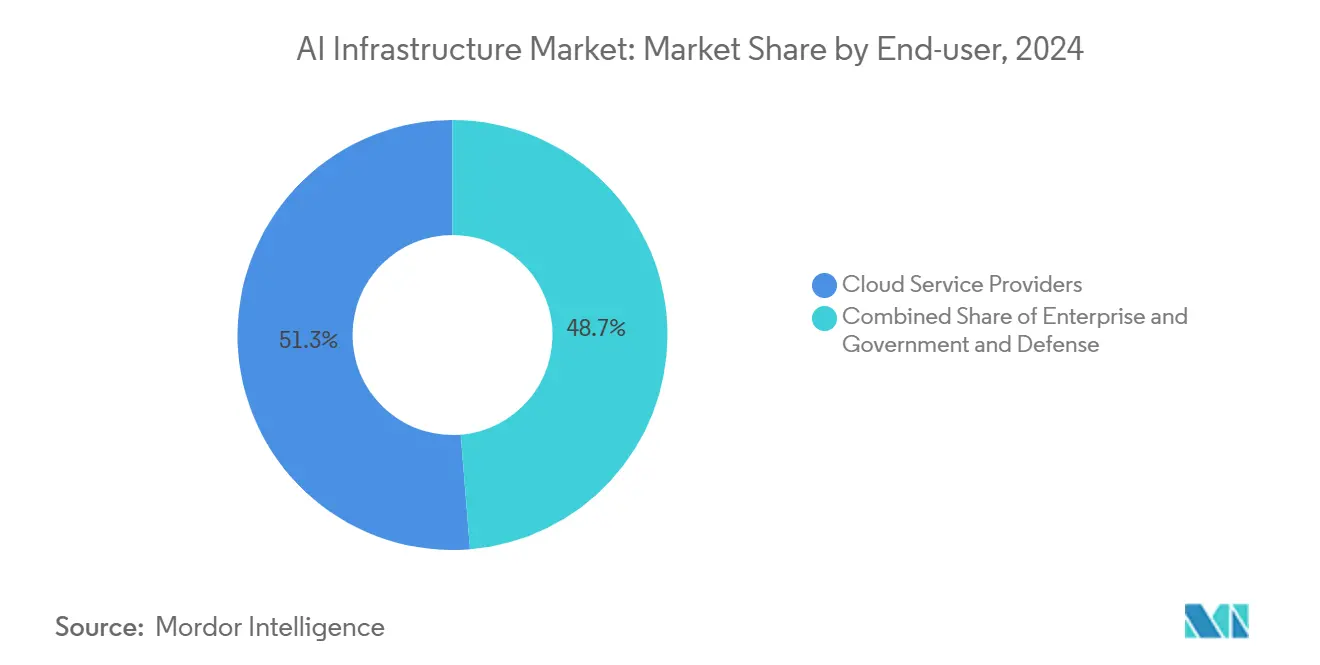
Note: Segment shares of all individual segments available upon report purchase
By Processor Architecture: GPU Supremacy With Emerging Alternatives
GPUs held 67.4% of 2024 revenue and retain the fastest 17.9% CAGR. The AI infrastructure market share for GPU deployments should remain high through 2030 because Blackwell-class devices preserve the CUDA toolchain while lifting performance per watt.
Specialized inference ASICs and FPGAs attract interest in power-constrained data centers. Cerebras WSE-3, Google TPU v5p, and AWS Inferentia 3 target latency-sensitive or cost-per-token workloads. Optical interconnect startups such as Ayar Labs seek to remove bandwidth bottlenecks, a development that could alter node design over the long term.
Geography Analysis
North America's 47.7% share in 2024 reflects an unrivaled concentration of hyperscaler campuses, semiconductor research hubs, and public-funded incentives like the CHIPS Act and Stargate initiative. Virginia's Data Center Alley maintains greater than 1.5 GW active power supply, while Texas and Oregon add renewables-backed capacity that keeps PUE ratios below 1.2. The AI infrastructure market continues to benefit from a pipeline of more than 40 greenfield facilities scheduled to open through 2026, though export restrictions affecting China-linked developers are reshaping supply contracts.
Asia-Pacific delivers the fastest 19.1% CAGR, with China, India, and Southeast Asian states directing funds toward national AI super-nodes, smart manufacturing corridors, and regional GPU clouds. Beijing-backed "computing vouchers" subsidize AI workloads, helping the region surpass 1,000 EFLOPS combined compute capacity by 2025. India's Digital Personal Data Protection Act pushes local processing, leading hyperscalers to co-build with domestic telecoms for edge AI clusters around 5G rollouts.
Europe balances expansion with climate goals. The Climate Neutral Data Centre Pact forces operators to hit aggressive energy-efficiency targets and source renewable power. Liquid cooling adoption, already at 20% of new builds in 2025, is expected to exceed 60% by 2027 to comply with Scope-2 reporting. Meanwhile, InvestAI financing pools accelerate Research and development partnerships across Germany, France, and the Nordics, yet budget scale still trails North American and APAC totals, compelling European operators to form cross-regional alliances such as Saudi-EU data-hub projects.
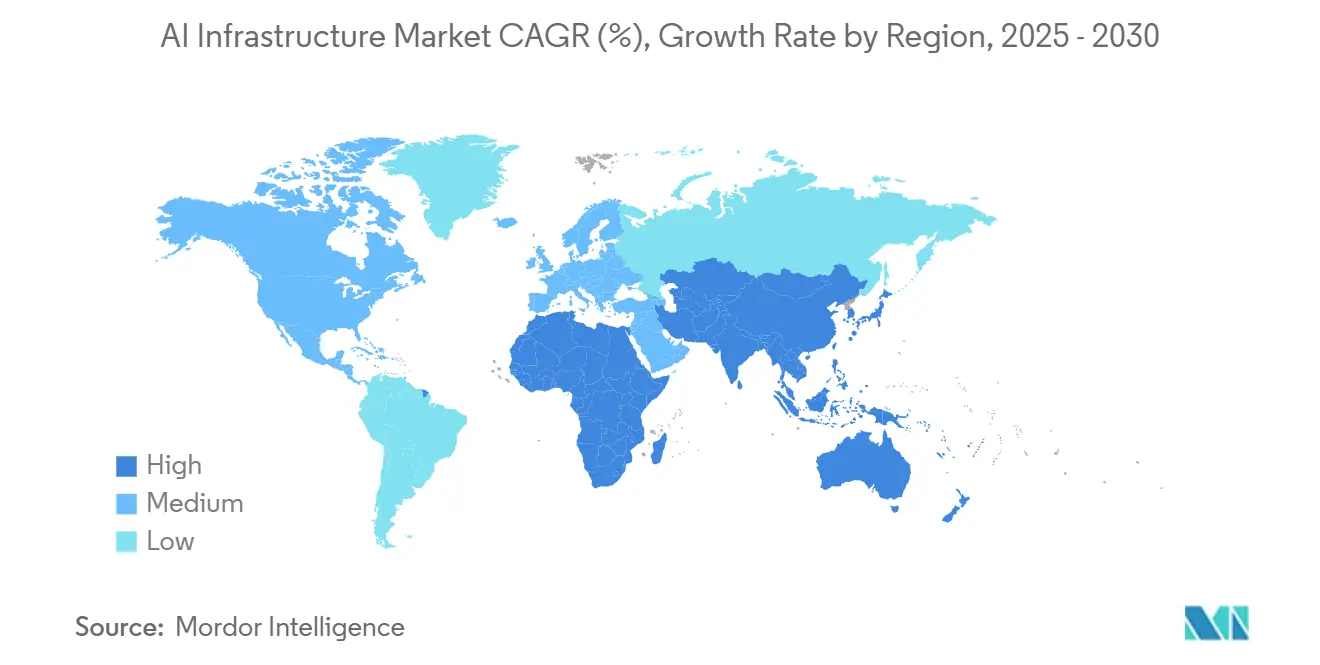
Competitive Landscape
The AI infrastructure market shows moderate concentration. NVIDIA leads in training silicon, fortified by the CUDA stack and a road-map cadence of annual double-digit performance gains. AMD accelerates through MI300X availability and a USD 10 billion partnership with Humain to stand up AI factories in Saudi Arabia and beyond. Intel widens reach by adding workstation GPUs and funding optical interconnect spin-offs that dovetail with Gaudi-class accelerators.
Hyperscalers are vertically integrating: Google’s TPUv5p, AWS’s Trainium 2, and Microsoft’s Maia chips reduce reliance on external GPU vendors, though each still buys tens of thousands of NVIDIA units for flagship model training. CoreWeave and Lambda define a “neocloud” tier that courts price-sensitive researchers with niche, bare-metal GPU offerings at up to 40% discount relative to big-three on-demand rates.
Edge infrastructure remains white space. Vendors such as Spectro Cloud and Zededa provide turnkey clusters hardened for manufacturing plants and hospitals, combining zero-touch provisioning and baked-in security. Optical interconnect innovators like Ayar Labs, funded by Intel, NVIDIA, and AMD, could alter chiplet-based package design and future-proof bandwidth needs above 100 Tb/s per node.
AI Infrastructure Industry Leaders
-
NVIDIA Corporation
-
Intel Corporation
-
Amazon Web Services
-
Microsoft (Azure)
-
Advanced Micro Devices
- *Disclaimer: Major Players sorted in no particular order
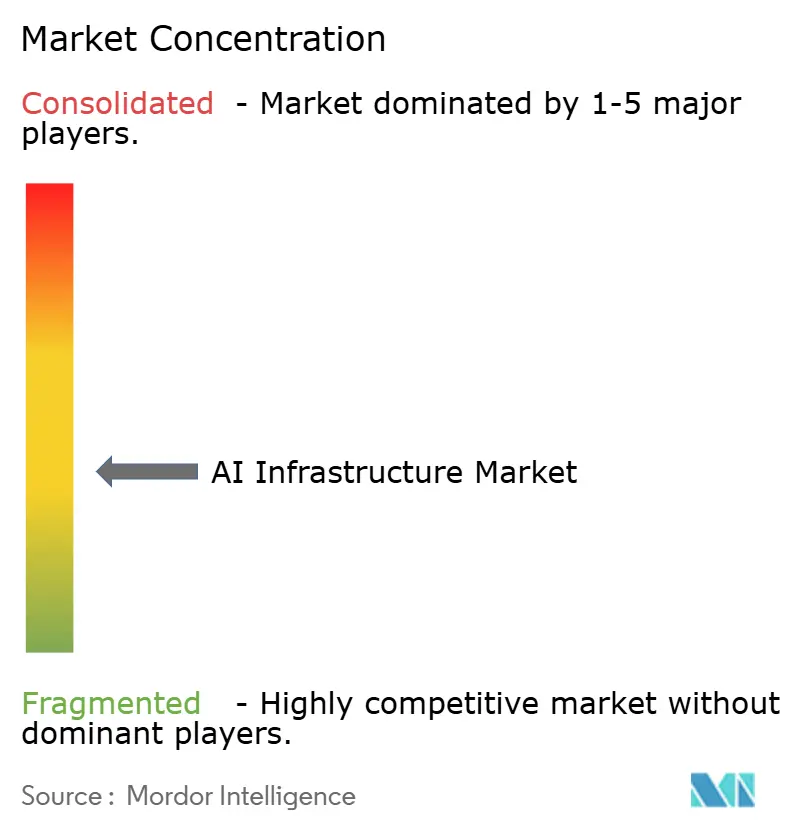
Recent Industry Developments
- January 2025: OpenAI, SoftBank, and Oracle formed Stargate with USD 500 billion funding to erect AI-optimized data centers in the United States, targeting 100,000 jobs and national resilience.
- March 2025: NVIDIA launched Blackwell Ultra GPUs and RTX PRO 6000 Blackwell Server Edition across Google Cloud and Microsoft Azure at GTC 2025.
- April 2025: NVIDIA committed USD 500 billion to expand domestic chip manufacturing, signaling unmatched capital depth for AI hardware.
- May 2025: AMD and Humain announced a USD 10 billion alliance to build AI factories in Saudi Arabia and elsewhere.
- June 2025: NVIDIA finalized the acquisition of Run:ai to strengthen multi-cluster resource scheduling for enterprise AI deployments
Research Methodology Framework and Report Scope
Market Definitions and Key Coverage
Our study treats the AI infrastructure market as all revenue generated from specialized hardware, system-level software, and high-performance data-center solutions that enable training and inference of machine-learning workloads at scale. This spans GPUs, AI accelerators, associated storage and memory, orchestration layers, and cloud or on-premises delivery models.
Scope exclusion: Consumer-grade edge devices and generic IT services that do not directly accelerate AI workloads are excluded.
Segmentation Overview
- By Offering
- Hardware
- Processor
- Storage
- Memory
- Software
- System Optimisation
- AI Middleware / MLOps
- Hardware
- By Deployment
- On-premise
- Cloud
- By End User
- Enterprises
- Government and Defence
- Cloud Service Providers
- By Processor Architecture
- CPU
- GPU
- FPGA/ASIC (TPU, Inferentia, Gaudi, Cerebras)
- Others
- By Geography
- North America
- United States
- Canada
- Mexico
- South America
- Brazil
- Argentina
- Rest of South America
- Europe
- United Kingdom
- Germany
- France
- Sweden
- Rest of Europe
- Asia-Pacific
- China
- Japan
- India
- Australia
- South Korea
- Rest of Asia-Pacific
- Middle East and Africa
- Saudi Arabia
- United Arab Emirates
- Turkey
- South Africa
- Rest of Middle East and Africa
- North America
Detailed Research Methodology and Data Validation
Primary Research
To validate desk findings, Mordor analysts interviewed data-center designers, hyperscale cloud architects, semiconductor road-map managers, and procurement leads across North America, Europe, and Asia Pacific. Guided conversations clarified average selling prices for GPU-dense servers, expected refresh cadences, and the realistic pace of liquid-cooling retrofits, filling gaps that public sources left open.
Desk Research
Analysts began with foundational data from tier-1 sources such as the US Energy Information Administration for data-center power trends, the Semiconductor Industry Association and WSTS for chip shipment volumes, and OECD AI Policy Observatory for policy drivers. Trade bodies like the Open Compute Project, AI Infrastructure Alliance, and Uptime Institute provided cost, rack-density, and cooling benchmarks that feed our supply-side build-out model. Company 10-K filings, investor decks, and earnings calls gave real-world pricing clues, and curated feeds on Dow Jones Factiva and D&B Hoovers flagged new capacity announcements. This list is illustrative; many additional public and paid references were reviewed for data cross-checks.
A second sweep collected import-export signals from Volza, recent liquid-cooling patents through Questel, and regional capital-expenditure statistics from government gazettes in the United States, China, and the EU, helping us anchor regional spreads and technology adoption curves.
Market-Sizing & Forecasting
A top-down construct starts with national data-center stock and annual AI-linked capex, which are then reconciled with GPU shipment records and server ASPs to approximate current value. Select bottom-up roll-ups, sampled supplier revenues, channel checks, and cloud usage disclosures fine-tune totals before a triangulation loop. Key variables in our model include GPU attach rate per rack, median server ASP, global cloud capex growth, liquid-cooling penetration, and power-usage-effectiveness shifts; each series is trended to 2030.
For forecasting, a multivariate regression couples those variables with macro pointers like AI workload growth and sovereign computing incentives. Scenario analysis stress-tests energy-price spikes and silicon supply shocks, and gaps in micro-level data are bridged with regional coefficient estimates vetted by domain experts.
Data Validation & Update Cycle
Outputs undergo two-step peer review, anomaly scans against third-party indicators, and management sign-off. Models are refreshed annually, with interim updates triggered by large fab capacity moves or cloud-spending inflections.
Why Mordor's AI Infrastructure Baseline Commands Reliability
Published numbers often diverge because firms vary scope (for example, some fold generic servers into totals) and apply dissimilar refresh cadences. Our disciplined filter locks onto hardware and system software directly tied to AI acceleration, and we update once fresh shipment or capex data land, keeping clients ahead of the curve.
Key gap drivers include wider component baskets in some studies, aggressive currency-conversion assumptions, or extrapolations that lack on-the-ground price validation. Mordor's mix of primary ASP inputs, annual model upkeep, and segment-specific exclusions curbs such drift.
Benchmark comparison
| Market Size | Anonymized source | Primary gap driver |
|---|---|---|
| USD 87.60 B (2025) | Mordor Intelligence | - |
| USD 58.78 B (2025) | Global Consultancy A | Includes only cloud workloads, omits on-prem refresh cycle |
| USD 135.81 B (2024) | International Analyst B | Adds generic servers and networking gear, uses one-time exchange rates |
In sum, Mordor Intelligence delivers a balanced, transparent baseline anchored to clearly traceable variables and repeatable steps, giving decision-makers a dependable view of the fast-moving AI infrastructure landscape.
Key Questions Answered in the Report
What is the current size of the AI infrastructure market?
The AI infrastructure market is valued at USD 87.6 billion in 2025 and is forecast to reach USD 197.64 billion by 2030, reflecting a 17.71% CAGR.
Which region leads spending today?
North America commands 47.7% of global spending thanks to hyperscaler campuses, semiconductor research and development, and supportive government incentives.
Which segment is growing fastest?
Software, although smaller than hardware, is expanding at 19.7% CAGR because orchestration, compilers, and MLOps platforms unlock higher hardware utilization.
How severe is the current GPU shortage?
Industry lead times stretch to 12–18 months, and pricing can exceed MSRP by up to 50% until new capacity ramps after 2026.
Page last updated on:
